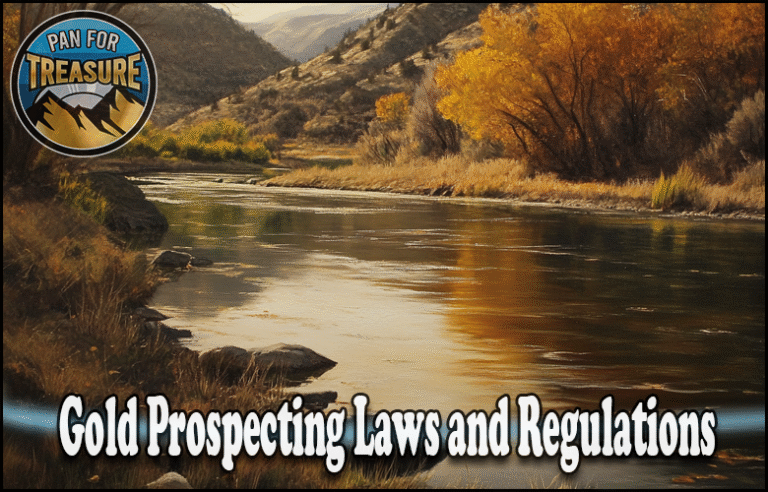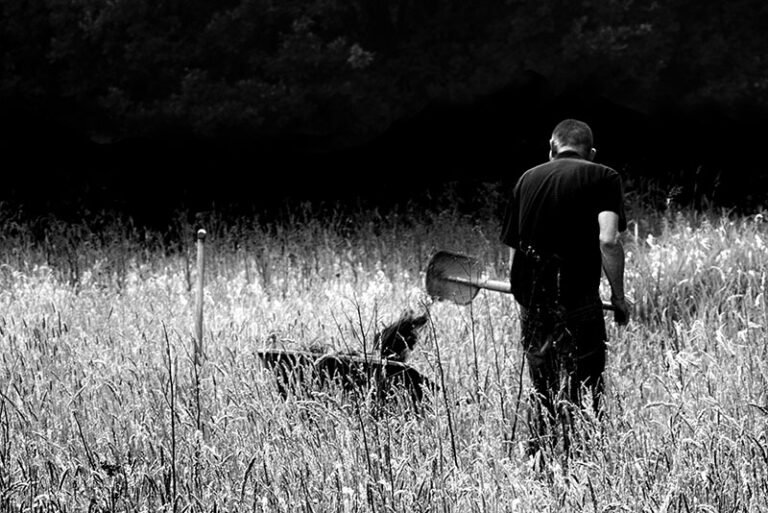
Disclosure: This Post Contains Affiliate Links; We earn a commission on purchases.
Idaho is a haven for gold prospectors, with its stunning landscapes and rich mining history.
However, it is essential to be aware of the laws and regulations surrounding gold panning to ensure a legal and enjoyable experience.
Whether you are a seasoned prospector or a beginner, understanding the gold panning regulations in Idaho is crucial to avoid penalties and violations.
The gold panning laws in Idaho cover various aspects, including permits, equipment, and mining locations.
Familiarizing yourself with these regulations will help you navigate the state’s gold-rich areas and enjoy your prospecting adventure without any legal complications.
Key Takeaways:
- Gold panning in Idaho is subject to specific laws and regulations.
- Prospectors must obtain the necessary permits to engage in small scale mining activities.
- Idaho Department of Water Resources issues the IDWR Small Scale Mining Authorization, which allows the use of limited equipment in search of minerals.
- Understanding the distinction between open and closed streams is vital for determining where you can legally engage in gold panning.
- Following responsible mining practices and preserving Idaho’s natural resources is an essential part of the gold panning experience in the state.
Understanding Small Scale Mining Permits in Idaho
Small scale mining in Idaho requires a permit known as the IDWR Small Scale Mining Authorization. This permit allows individuals to use limited equipment, such as suction dredges and non-powered sluice boxes, in search of minerals.
The IDWR Small Scale Mining Authorization is valid for one year and can be obtained from the Idaho Department of Water Resources. This permit is essential for anyone engaging in small scale mining activities below the ordinary high watermark of a river or stream in Idaho using mechanized equipment.
The regulations governing small scale mining are outlined in the Idaho Small Scale Mining Program Instructions and IDAPA 37.03.07 – Stream Channel Alteration Rules. These documents provide detailed guidelines on the proper procedures, equipment restrictions, environmental protection, and safety measures for small scale mining in Idaho.
It is important for prospective miners to familiarize themselves with the IDWR Small Scale Mining Authorization requirements and adhere to the rules outlined in the Idaho Small Scale Mining Program Instructions and IDAPA 37.03.07. By obtaining the necessary permit and following the regulations, miners can ensure a legal and responsible mining experience.
Do I Need a Permit for Small Scale Mining in Idaho?
Prospectors engaging in small scale mining activities below the ordinary high watermark of a river or stream in Idaho using mechanized equipment, such as suction dredges or powered sluice boxes, are required to have an IDWR Small Scale Mining Authorization. This permit is necessary for conducting small scale mining on open streams and rivers and can be obtained from the Idaho Department of Water Resources. However, special permits may be required for certain areas, such as the South Fork Clearwater River and McCoy Creek Drainage.
If you are planning to engage in small scale mining activity in Idaho using mechanized equipment, it is important to obtain the IDWR Small Scale Mining Authorization to ensure that your activities are legal and compliant with the regulations. This permit not only grants you the permission to conduct small scale mining, but it also demonstrates your commitment to responsible mining practices.
The IDWR Small Scale Mining Authorization is specifically designed to regulate small scale mining activities and protect the environment. By obtaining the permit, you are acknowledging the importance of preserving Idaho’s natural resources and ensuring the sustainability of small scale mining operations.
Understanding the IDWR Small Scale Mining Authorization
The IDWR Small Scale Mining Authorization is a permit issued by the Idaho Department of Water Resources. It grants individuals the authority to conduct small scale mining activities using mechanized equipment in Idaho’s rivers and streams below the ordinary high watermark.
This permit is essential for prospectors who wish to use suction dredges or powered sluice boxes in their mining operations. It ensures that you are complying with the regulations set forth by the Idaho Department of Water Resources and helps protect the integrity of Idaho’s waterways.
While the IDWR Small Scale Mining Authorization covers most open streams and rivers in Idaho, it is important to note that special permits may be required for certain areas. For example:
“Special permits may be required for small scale mining activities in the South Fork Clearwater River and McCoy Creek Drainage. It is advisable to consult with the Idaho Department of Water Resources to determine if any additional permits are necessary for your specific mining location.
By obtaining the IDWR Small Scale Mining Authorization, you can ensure that your small scale mining activities are in compliance with the regulations and contribute to responsible and sustainable mining practices in Idaho.
| Permit Required | Permitted Activities |
|---|---|
| IDWR Small Scale Mining Authorization | Small scale mining using mechanized equipment (suction dredges, powered sluice boxes) |
| Special Permits (in certain areas) | Small scale mining in the South Fork Clearwater River and McCoy Creek Drainage |
It is important to thoroughly understand the requirements and regulations surrounding small scale mining in Idaho to ensure that your mining activities are legal and compliant. By obtaining the necessary permits, you can enjoy the thrill of small scale mining while also protecting Idaho’s natural resources.
Obtaining an IDWR Small Scale Mining Authorization (Letter Permit)
To obtain an IDWR Small Scale Mining Authorization, individuals can download and print the IDWR Letter Permit and accompanying instructions from the IDWR website. The completed form and appropriate fee can be submitted in person at any IDWR office or sent by postal mail. The permit is typically processed within a few minutes if submitted in person or returned by email or postal mail if sent by mail.
Equipment Covered by the IDWR Small Scale Mining Authorization
In order to engage in small-scale mining activities in Idaho, prospectors must obtain the IDWR Small Scale Mining Authorization. This permit allows individuals to utilize mechanized equipment while adhering to specific restrictions and guidelines. The IDWR Small Scale Mining Authorization covers a range of equipment, including:
- Suction dredges
- Powered sluice boxes
- High bankers
It’s important to note that there are limitations on the specifications of the equipment. Suction dredges used under this authorization must have a nozzle diameter of five inches or less. Additionally, the motors or engines employed in the equipment must be rated at 15 horsepower or less. Any equipment exceeding these limits will require a Joint Application for Stream Channel Alteration Permit.
By obtaining the IDWR Small Scale Mining Authorization, prospectors can utilize small-scale, mechanized equipment within these defined parameters, ensuring compliance with Idaho’s regulations while pursuing their mining activities.
Restrictions on Equipment:
“Suction dredges must have a nozzle diameter of five inches or less, and motors or engines used must be rated at 15 horsepower or less.”
List of Equipment Covered:
- Suction dredges
- Powered sluice boxes
- High bankers
Related Gold Panning Information
Understanding Open and Closed Streams for Small Scale Mining
Small scale mining activity in Idaho is subject to specific restrictions regarding the type of streams and rivers where mining is permitted. To ensure compliance with the regulations, prospectors must familiarize themselves with the IDWR Small Scale Mining Program Instructions. These instructions provide a comprehensive list of open streams and the corresponding mining seasons. It is crucial for prospectors to review this information carefully and ensure they are conducting their mining activities in designated open areas to avoid penalties and violations.
The Environmental Protection Agency (EPA) also maintains a list of open and closed waters in Idaho, which can serve as an additional resource for miners. By cross-referencing the EPA’s list with the IDWR Small Scale Mining Program Instructions, prospectors can gain a clear understanding of which streams are open for mining and which are closed.
Mining Area Selection
When selecting a mining site, it is vital for prospectors to consider the open and closed classifications of nearby streams. Failing to do so may result in unintentional violations of mining regulations. By adhering to the guidelines provided by the IDWR Small Scale Mining Program Instructions, miners can ensure that their activities are both legally compliant and environmentally responsible.
Benefits of Mining in Open Streams
Mining in open streams not only guarantees compliance with the law but also helps protect sensitive ecosystems. Open streams are carefully selected to minimize environmental impact, ensuring the preservation of wildlife habitats and natural resources.
Risks of Mining in Closed Streams
Conversely, mining in closed streams poses significant risks to both the environment and the miner. Operating in areas that are not designated for mining can lead to disturbances in fragile ecosystems and potential legal consequences, including fines and permit revocations.
Understanding Stream Classifications
The IDWR Small Scale Mining Program Instructions classify streams into two categories: open streams and closed streams. Open streams are those where mining is permitted, subject to the necessary authorizations, while closed streams are off-limits for mining activities.
| Open Streams | Closed Streams |
|---|---|
| Stream A | Stream X |
| Stream B | Stream Y |
| Stream C | Stream Z |
Note: The table above is for illustrative purposes and does not reflect the actual open and closed streams in Idaho.
Prospectors must consult the IDWR Small Scale Mining Program Instructions for the most up-to-date information on open streams and the corresponding mining seasons. This ensures that mining activities are conducted within legal boundaries and contributes to the overall conservation and sustainability of Idaho’s natural resources.
Non-Mechanized Activity and Permits
Non-mechanized activity, such as using pans, rockers, and other hand tools, does not generally require a small scale mining permit in Idaho. This type of equipment allows prospectors to engage in recreational gold panning without the need for formal authorization. However, it’s important to note that certain thresholds may still necessitate a permit, as outlined in the IDWR Small Scale Mining Program Instructions.
While non-mechanized equipment is generally exempt from permitting requirements, there are specific parameters to consider. For example, if you are processing more than one-quarter cubic yard of streambed material per hour or disturbing more than 33% of the stream width, you may be required to obtain a small scale mining permit. These regulations are designed to ensure responsible mining practices and protect the environment.
It’s crucial to review the IDWR Small Scale Mining Program Instructions thoroughly to understand the permitting thresholds and guidelines. By familiarizing yourself with these requirements, you can ensure compliance with the relevant regulations and enjoy your gold panning adventures in Idaho responsibly.
The History of Gold Panning in Idaho
Idaho boasts a captivating gold mining history that dates back to the 1860s. It all began with the very first gold discovery along the Clearwater River, a significant moment that set the stage for a thriving industry. Since then, the state of Idaho has recognized the importance of regulating mining activities to ensure the protection of the environment and the preservation of its precious natural resources.
One crucial piece of legislation that governs gold mining in Idaho is the Stream Channel Protection Act. This act is designed to regulate the alteration of stream channels and ensure responsible mining practices. Miners are required to obtain permits from the Idaho Department of Water Resources to comply with this essential legislation.
Glimpsing into the Past: The First Gold Discovery
The first gold discovery in Idaho, made along the Clearwater River, marked the beginning of a significant era in the state’s history. Prospectors flocked to the region in search of their fortunes, sparking a gold rush that would shape the landscape and heritage of Idaho.
“The first gold discovery made along the Clearwater River laid the foundation for Idaho’s prosperous gold mining industry. Prospectors from all walks of life ventured to the region, captivated by the promise of untold riches.”
As the gold rush unfolded, the impact of mining became increasingly apparent, raising concerns about the need for regulation to protect both the natural environment and the interests of future generations.
The Stream Channel Protection Act: Safeguarding Idaho’s Resources
The Stream Channel Protection Act is an integral part of Idaho’s commitment to responsible mining practices. Enacted to regulate the alteration of stream channels, the act ensures that mining activities are carried out in a manner that minimizes environmental impact and preserves the integrity of Idaho’s waterways.
Under this act, miners are required to obtain permits from the Idaho Department of Water Resources to conduct any alterations to stream channels. These permits are crucial in ensuring that mining operations align with the state’s environmental guidelines.
The Stream Channel Protection Act is an essential tool in striking a balance between the economic benefits of mining and the preservation of Idaho’s natural heritage.
Popular Gold Panning Locations in Idaho
Idaho offers a variety of popular gold panning locations for both seasoned prospectors and beginners. The state’s rich mining history and diverse landscapes make it an ideal destination for those seeking the thrill of finding gold. Whether you prefer the mountainous terrain of the Boise Basin, the scenic beauty of the South Fork Clearwater River, the historical significance of the Coeur d’Alene Mining District, the charming town of Stanley, or the breathtaking Salmon River Canyon, there are plenty of opportunities to strike it rich.
If you’re looking for a true gold rush experience, head to the Boise Basin. This area was once the center of Idaho’s gold mining activity during the 19th century, and there are still ample opportunities to find gold here today. Take in the stunning mountain views while panning along the rivers and streams that crisscross the region.
The South Fork Clearwater River is another popular destination for gold panning. Located in central Idaho, this scenic river offers not only the possibility of finding gold but also a chance to enjoy the beauty of the surrounding natural landscape. Spend a day exploring the riverbanks and try your luck at striking gold.
The Coeur d’Alene Mining District is known for its silver mining history, but there is still gold to be found in the area. This district encompasses a large portion of northern Idaho and offers a mix of mining opportunities, from placer deposits to lode mines. Explore the rich history and geological diversity of the district while searching for that elusive yellow metal.
For a more remote and rugged gold panning experience, venture to the town of Stanley. Located in the heart of the Sawtooth Mountains, Stanley is surrounded by pristine wilderness and offers access to the Salmon River. This majestic river cuts through the Salmon River Canyon, providing ample opportunities for prospecting alongside breathtaking views.
As you embark on your gold panning adventure in Idaho, remember to adhere to the state’s gold panning laws and regulations. Respect the environment and practice responsible mining techniques to ensure the preservation of Idaho’s natural beauty for future generations of prospectors.
Conclusion
Gold panning in Idaho is an exciting recreational mining activity that caters to individuals of all skill levels. By adhering to the gold panning laws and regulations of Idaho, obtaining the necessary small scale mining permits, and employing responsible mining practices, prospectors can relish in a legal and enjoyable experience while prioritizing the preservation of Idaho’s stunning natural landscapes.
Embarking on a golden adventure in the Gem State requires a thorough understanding of the legal framework surrounding gold panning. Familiarize yourself with the IDWR Small Scale Mining Authorization and the IDAPA 37.03.07 – Stream Channel Alteration Rules to ensure compliance with the small scale mining program instructions. Additionally, be aware of open streams and rivers where small scale mining is permitted, as outlined by the Idaho Department of Water Resources.
Preserving Idaho’s natural beauty is paramount. Implement responsible mining practices, such as properly disposing of waste and restoring any disturbed areas, to mitigate negative environmental impacts. Remember that gold panning is not just about finding valuable treasures but also about appreciating and safeguarding the remarkable landscapes of Idaho.
Source Links
- https://idwr.idaho.gov/streams/recreational-mining-permits/faqs/
- https://idwr.idaho.gov/streams/recreational-mining-permits/

Meet Ryan Conlon, the passionate owner and driving force behind Pan for Treasure.
With an unwavering love for the art of gold panning, Ryan has transformed his enthusiasm into a thriving community hub for fellow treasure seekers. info@panfortreasure.com
A seasoned gold panning enthusiast, Ryan’s journey began with a simple pan and a dream, evolving into a deep appreciation for the history, geology, and thrill of uncovering precious metals.
Subscribe to Our Newsletter






